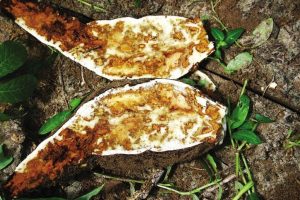Rwandan farmers lack improved cassava varieties that are resistant to the main cassava diseases in Rwanda, namely Cassava Brown Streak Disease (CBSD) and Cassava Mosaic Disease (CMD), locally known as Kabore and Ububembe, respectively.
Cassava is one of the most important and nutritious food crops in Rwanda. It is among the priority crops promoted by the government to ensure food self-sufficiency and increased incomes by farming households. According to the data published by the National Institute of Statistics of Rwanda, cassava is the second most grown crop in terms of cultivated area in 2018, and the fourth most consumed staple crop in Rwanda.
CBSD and CMD have singly or together affected cassava productivity in Rwanda, threatening the income and food security of farmers and other actors that depend on the crop.
“There are two main diseases that attack cassava, not only in Rwanda but also in the region. These are CMD and CBSD. The latter poses a serious threat because once cassava is infected with CBSD, root tubers spoil, leaving almost nothing to be consumed by farmers,” said Dr Charles Bucagu, Deputy Director General of Agriculture, Research and Technology Transfer at the Rwanda Agriculture and Animal Resource Development Board (RAB).
The Government of Rwanda has been working closely with partners to find a lasting solution to this problem, and ensure that farmers have access to clean, safe, and productive cassava seed.
The solution to both CMD and CBSD
In partnership with RAB, IITA has been implementing a four-year project since 2017, which introduced new cassava varieties and seed quality management techniques to fight the CBSD and CMD diseases in Rwanda.
The project has implemented various approaches to curb the two deadly cassava viral diseases. Among them, the introduction of elite clones with high dual tolerance to CBSD and CMD that are already advanced or officially released in other African countries where CBSD is endemic. Up to 17 elite clones, each with about 200 tissue culture (TC) plantlets, were introduced.
The introduced germplasm has been managed through post-flask management, macropropagation, and field multiplication. Currently, evaluation trials have been established at three sites representing the major cassava agroecologies in Rwanda.
Moreover, the project identified new elite-resistant clones from introduced true cassava seed to quickly identify adapted CBSD/CMD resistant elite clones for Rwanda, through the identification of another set of elite clones with high CBSD/CMD resistance among other traits of importance for future variety options to farmers and other end users.
In this regard, more than 40,841 true cassava seeds in three batches from IITA cassava breeding platforms in Eastern and Western Africa were introduced from countries where breeding for resistance to viral problems is advanced. The seeds were generated from parents with a strong genetic background for dual resistance to CBSD/CMD. The seeds have been germinated mostly by the field method and advanced through different early stages of selection depending on the batch.
In Rwanda, 531 clones have undergone clonal evaluation at two sites to identify the best ones for evaluation of preliminary yield performance. Moreover, yellow clones with high levels of betacarotene content have been identified, which opens opportunities for vitamin A-rich cassava breeding in Rwanda.
“The project had introduced both elite clones and biological seeds that have directly and positively impacted the genetic diversity for CBSD/CMD dual resistance now and future breeding efforts in Rwanda. Several CBSD/CMD resistant and high yielding varieties that carry good consumer preference and other end-use traits have been identified for Rwanda,” highlighted Dr Silver Tumwegamire, CBSD Control Project Leader.
The project also found it important to make use of the locally adapted and highly preferred existing varieties and conducted germplasm collection missions across Rwanda. A total of 55 cassava accessions were collected and morphologically characterized under field gene bank conditions at Rubona station. A carefully selected core of 30 accessions that are popular were sent to KEPHIS (Kenyan Plant Health Inspectorate Services) for virus cleaning and 19 of them have been returned for integration into the seed system for farmers’ access or future breeding efforts in Rwanda.
Already 10 of the local varieties have been used together with the new introduced elite clones to generate new breeding populations. Up to 11,261 biological seeds have been produced, and some have already been germinated to identify new clones that combine exotic and local traits.
Pre-basic and basic clean seed production and dissemination systems are a critical step to the delivery of quality seed of any crop. This is the reason why IITA has introduced and built the capacity for Semi-Autotrophic Hydroponic (SAH) at Rubona station. The technology will help increase the multiplication rates of tissue culture-derived plantlets while overcoming the very low survival rates during acclimatization.

IITA introduced the Semi-Autotrophic Hydroponic (SAH) at Rubona station to increase the multiplication rates of tissue culture-derived plantlets
The project also has established two screen houses and five basic seed centers in Rwanda to test the feasibility of using the macropropagation technique to support field basic seed multiplication, and creating a formal structure of clean seed multiplication and dissemination of early generation seed.
“Through the project, Rwanda has made gains in terms of resistant elite clones and biological seed all of which will enable us to identify high yielding cassava seeds and resistant varieties. It has also enabled us to make efforts to streamline the cassava seed value chain in Rwanda. Thanks to this project, we now have cassava seed standards to ensure seed quality control for cassava in Rwanda,” said Dr Athanase Nduwumuremyi, Head of the cassava research and technology transfer program at RAB.
IITA as the lead partner has engaged all the key partners, mainly RAB and other strategic partners in cassava seed value chain, in ensuring control of CBSD and CMD epidemics in Rwanda through variety development and establishment of a sustainable clean seed production and seed delivery system.





No Comments